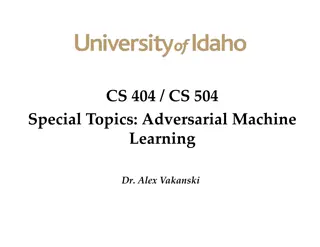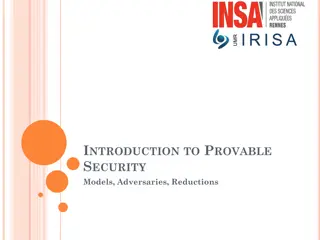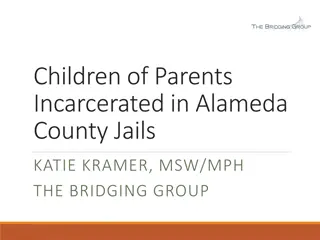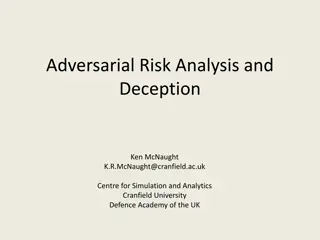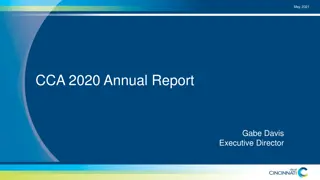Understanding Biological Adversaries: Education Levels and Demographics
Exploring the traits of biological adversaries, this study reveals that perpetrators with higher education levels are more likely to successfully use chemical and biological agents. Success tends to increase with age and years of activity. Most individual perpetrators originate from the MENA region, moving to Europe or North America before engaging in activities. The data analysis provides insights into the characteristics and behaviors of biological threats.
Download Presentation

Please find below an Image/Link to download the presentation.
The content on the website is provided AS IS for your information and personal use only. It may not be sold, licensed, or shared on other websites without obtaining consent from the author. Download presentation by click this link. If you encounter any issues during the download, it is possible that the publisher has removed the file from their server.
E N D
Presentation Transcript
Profiling the Biological Adversary Gary Ackerman February 23, 2018 This material is made possible by support from the Chemical and Biological Defense (CBD) Division, U.S. Department of Homeland Security, under award # 2012-ST-061-CS0001. The views and conclusions contained in this document are those of the authors and should not be interpreted as necessarily representing the official policies, either expressed or implied, of the U.S. Department of Homeland Security or START.
National Consortium for the Study of Terrorism and Responses to Terrorism A Center of Excellence of the U.S. Department of Homeland Security Reasons for Non-Pursuit of Biological Weapons
National Consortium for the Study of Terrorism and Responses to Terrorism A Center of Excellence of the U.S. Department of Homeland Security Seeking Answers Through Data Analysis Analysis performed on: Chemical and Biological Non-State Adversaries Database (CABNSAD) Primary dataset of all individual perpetrators Secondary dataset with all individuals that were members of organizations aggregated appropriately. Types of Analysis: Descriptive statistics Bivariate correlations Analysis of variance (ANOVA) Simple linear regression Multinomial logistic regression
National Consortium for the Study of Terrorism and Responses to Terrorism A Center of Excellence of the U.S. Department of Homeland Security Sample Bivariate Comparison: CB Activity results by Education Level
National Consortium for the Study of Terrorism and Responses to Terrorism A Center of Excellence of the U.S. Department of Homeland Security
National Consortium for the Study of Terrorism and Responses to Terrorism A Center of Excellence of the U.S. Department of Homeland Security Key Takeaways: Data Analysis Demographics Education Levels Biological perpetrators are generally more educated than chemical perpetrators. Education Levels The higher the level of education, the more likely a perpetrator was to successfully use the CB agent(s); vast majority of cases of CB use (with known education level) involve perpetrator with at least an undergraduate education. Age Successful perpetrators are generally older with more years of CB activity. Origin and Activity Majority of individual perpetrator originating from MENA moved to Europe or North America prior to engaging in CB activities.
National Consortium for the Study of Terrorism and Responses to Terrorism A Center of Excellence of the U.S. Department of Homeland Security Key Takeaways: Data Analysis CB Activity Perpetrator Type Lone actors comprise over half of all perpetrator entities and are much more likely to use biological agents than any other perp type. Organization Type Members of a formal organization have far more CB activity years. Casualties Cults, such as Aum Shinrikyo and the People s Temple, achieved highest number of casualties. Casualties Far more (non-fatal) injuries when perpetrator had a postgraduate college education. Targeting Majority of perpetrator entities targeted food and/or drink.
National Consortium for the Study of Terrorism and Responses to Terrorism A Center of Excellence of the U.S. Department of Homeland Security Biological Adversary Psychology General Components Full Psychological Model Common (Cognitive) Process Toward Ideological Violence Decision Point Model Detailed Components Based On Portions of the Literature Review Motivation-Influencing Factors at each Decision Point Analysis of Past Perpetrator Motivations and Behavior Alternative Hypotheses Portions of the IS Profile
National Consortium for the Study of Terrorism and Responses to Terrorism A Center of Excellence of the U.S. Department of Homeland Security Bio Adversary Psychology Components
National Consortium for the Study of Terrorism and Responses to Terrorism A Center of Excellence of the U.S. Department of Homeland Security Psychological Decision Points in Use of Bio Unconventional Area Denial (+++) Publicity (++) Catastrophic Casualties [50K] (+++) Disruption of Agriculture (+++) Deterrence (+) Status Building / Factionalization (++) Propensity to Innovate (++) High Technology Fascination (+) Narcissism / Self-Glorification (+) Lack of Interest in Innovation (- -) Low Risk Threshold for Failure (- -) Weapons Large Scale Incapacitation (++) Area Denial (++) Psychological Impact (+) Publicity (+) Catastrophic Casualties [>100K] (+++) Water Supply (+) Immediate Gratification / Impatience / Urgency (- -) State Sponsor (- -) Low Self-Harm Threshold (- - -) Concerns about Counter-terrorism Reaction (- -) Bio Desire to Harm but NOT Kill on a Large Scale (++) Bio Fetish (+++) Revenge for Previous CB Use (+++) Exclusive Targeting of IT Infrastructure (- - -) Targeting of CI (- - -) RN or C Fetish (- - -)
National Consortium for the Study of Terrorism and Responses to Terrorism A Center of Excellence of the U.S. Department of Homeland Security Bio Adversary Psychological Profile Combining the results of the various analyses has enabled START to develop a preliminary psychological profile of VNSAs who seek to acquire and use CB weapons. Result is subject to limitation and constraints and is not comprehensive. Relevant VNSA traits and factors exist in the following categories. Dispositional Factors Situational Factors Ideology Motivation / Goals Selection of CB Weapons as a Means of Goal Achievement
National Consortium for the Study of Terrorism and Responses to Terrorism A Center of Excellence of the U.S. Department of Homeland Security Key Takeaways: Psychological Profile Dispositional Factors Youth-Associated actors under the age of 40, with a high risk tolerance, reliance on emotions in decision making, and propensity for violence Intelligence and Education CB actors are fairly well educated, with most having an undergraduate degree and many having a postgraduate degree Mental Health Status VNSAs with mental disorders that lead to a higher propensity for violence may be more likely to use CB weapons than those with mental disorders that lead to distortion of normal cognitive processes. Situational Factors Group Membership Most CB actors have belonged to a group or unaffiliated cell Social Influences Toward CB Weapons Use Friends, family, colleagues and organizational leadership with beliefs/opinions about CB weapons use.
National Consortium for the Study of Terrorism and Responses to Terrorism A Center of Excellence of the U.S. Department of Homeland Security Key Takeaways: Psychological Profile Ideology Religious and Personal/Idiosyncratic more likely to be associated with CB weapons use than other ideologies like criminal, cult, secular, ethno-nationalist and others Religious Islamic (Sunni) Is the religious ideological subtype most strongly correlated with CB use Personal/Idiosyncratic Is the ideological type most strongly correlated with CB use to attack an individual (often out of revenge for a perceived injustice) Cult Ideology associated most with successful use of CB weapons, including injuries and fatalities BW vs. CW use cults and those with secular left-wing ideologies are more likely to use both C and B weapons, whereas other ideological groups are more likely to pursue CW than BW
National Consortium for the Study of Terrorism and Responses to Terrorism A Center of Excellence of the U.S. Department of Homeland Security Key Takeaways: Psychological Profile Motivation/Goals Organizational or Ideological Group Membership VNSAs who are members of a group or organization tend to adopt the group s CB weapons goals and motivations Non-Members of an Ideological Group VNSAs who do not belong to an ideological group often have self-focused goals of harming someone who has harmed them, and are motivated by revenge Selection of CB Weapons as Means to Goal Achievement VNSA Groups/Organizations Selection of CB weapons often occurs when they are required to achieve a larger goal, or when CB weapons are easy to access and use Lone Actors Selection of CB weapons is usually utilitarian, and use of CB weapons is integral to achieving a larger goal
National Consortium for the Study of Terrorism and Responses to Terrorism A Center of Excellence of the U.S. Department of Homeland Security Bio Adversary Threat Indicators Added psychological findings to existing set of Bio Adversary Threat Indicators Packaged into user-friendly Excel worksheet
National Consortium for the Study of Terrorism and Responses to Terrorism A Center of Excellence of the U.S. Department of Homeland Security Learning Quiz: Poisonous Minds Beta Version: www.startdemoserver.org





